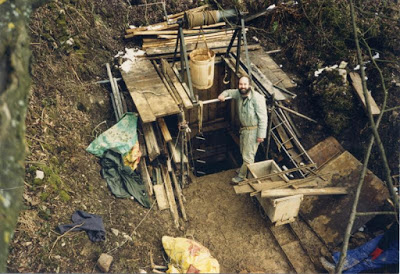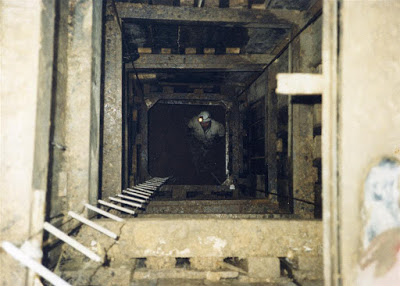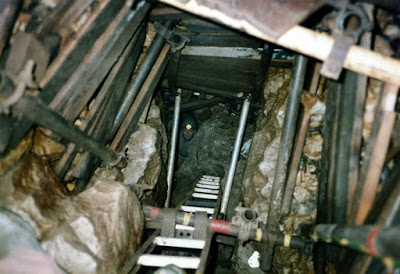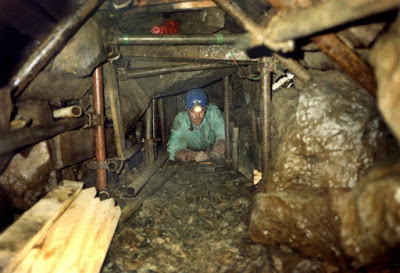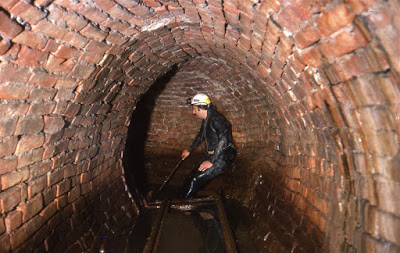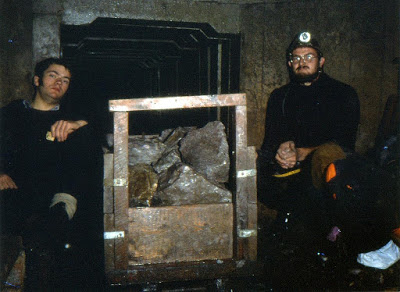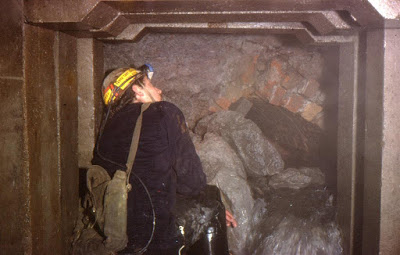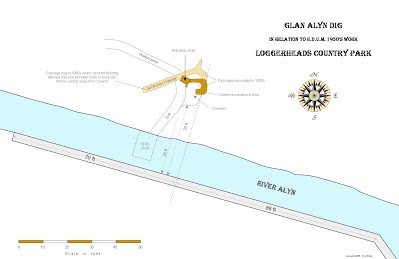-------------------------------------------------------------------------------------------------------------------------
Glan Alyn Dig
Loggerheads Country Park
This
area of the River Alyn's stream-bed suffered serious leakage via
swallets into the mines. Many swallows were identified and excavated by
Halkyn Mines in the 1930s before being filled and sealed.
Dye introduced into swallows at the Glan Alyn area in the 1930s took 20
hours to re-appear in mine workings on the Llyn-y-Pandy
vein, 1.7 miles to the north. One of these swallows was excavated by
miners to a depth of 7m from where they drove a horizontal passage under
the north bank. After a few metres they encountered a small chamber "through which all feeds in the area appeared to pass". A passage "at times of small capacity" led off which they explored for 22m before filling the entire cave with “slimes & ashes“ (see first photo below).
In
the early 1980s, cavers were granted consent by Clwyd County Council to
dig a shaft from the river bank directly downwards in the hope of
holing through the chamber roof. The diggers blasted through solid rock
to a point just 1m from the chamber, but flooding at the bottom made
further work impossible and the entrance shaft was
refilled, It is subsequently discovered that the dig dries out.
Consequently, GCC re-negotiated access in about 1998 and re-commenced
excavation. Unfortunately it now appears that the chamber is not
where shown on the 1930s plan and the dig has been abandoned.
Dozens
of swallows were excavated by Halkyn District United Mines (HDUM) in the 1930s, but nearly all degenerated
into impenetrable fissures. The Glan Alyn site was the only one known to
have encountered an active cave passage.
The main body of the unpublished 1938 HDUM report is available as a PDF download on Page 15: Springs, Sinks and Shakeholes (see under "Alyn Gorge Swallows").
Inside the small chamber
found in the 1930s.
Photo from an unpublished HDUM report of 1938
CLICK IMAGE TO ENLARGE
Survey of the old dig (pale brown), the latest dig (darker brown) and
the chamber and
watercourse found by miners in the 1930s from the shaft in the river-bed
(Based upon the original 1930s report by HDUM)
1980s cavers close-timbered entrance shaft
1998 project at a depth of 25 feet
showing ventilation pipe
-----------------------------------------------------------------------------------------------------------------------------
Gas Pot
Esclusham Mountain
An
old dig from the 1980s on the Aber Sychnant. Blasted vertically
downwards to a depth of 130 feet. Work was made easier by being able to
utilise the many open fissures as dumping sites for waste rock. Each
visit involved blasting followed by scaffolding to enlarge and
stabilise. At the base of the dig a stream was encountered which
followed the dip of the basement beds almost horizontally, but in this
area the boulders were larger than cars to a height of almost 80 feet
above rendering the scaffolding ineffective and the dig was abandoned.
Well over 3000 man-hours were spent on the project, plus tons of
scaffolding and timber, not to mention the many pounds in weight
of explosives. Cavers later discovered the cave system that this
dig drains into, via nearby mine workings. The cave is now north wales'
largest and longest cave system Ogof Llyn Parc.
Note:
It was at one time common for cavers to hold explosives licences.
Today the safety requirements are far more stringent making the
obtaining of a licence far more difficult.
Looking vertically down at a depth of 60 feet
A short horizontal section at a depth of 100 feet
------------------------------------------------------------------------------------------------------
Park Day Level
Minera
This drainage
level intersects natural feeders entering from the Minera Master Cave.
One mile along the tunnel however, a collapse prevented access to the
area of potential new cave. In order to dig through the fall in the late
1970s, rails were re-laid for hundreds of metres and a mine wagon
was purpose-made. This then enabled heavy concrete lintels to be
transported to the working face. After digging into the blockage, waste
was then trammed back almost half a mile, then the lintels were erected
to secure the roof. After successfully digging through after two years
work, a more intimidating area of shale collapse was found beyond and
the dig was abandoned.
Brick-lined section of the level not far from the portal
Taking a break in the miners 'cabin' near the working face
Almost through
